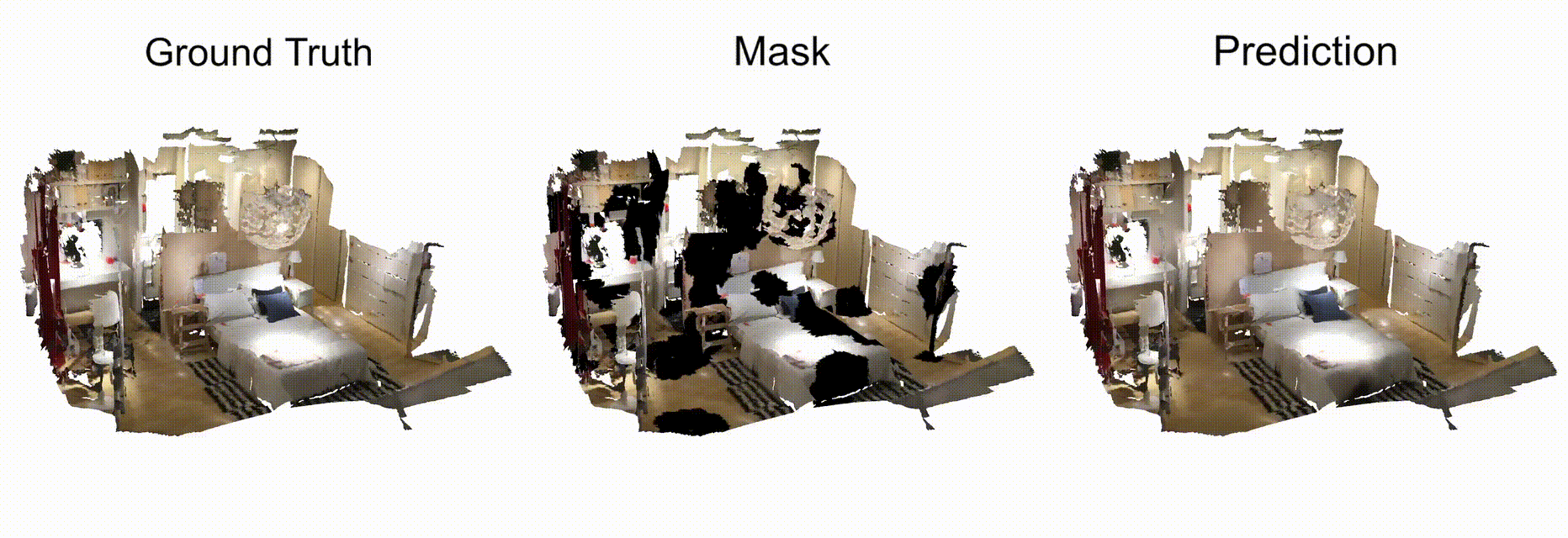Inpainting with deep learning looks great these days but what if the pixels live on a 3D model instead of a flat, rectangular image? 🤔
Docs: Thesis | Video 1 | Video 2
We present the Surface Texture Inpainting Network (STINet), a graph neural network-based model that generates complete surface texture for partially textured 3D meshes. In contrast to 2D image inpainting which focuses on predicting missing pixel values on a fixed regular grid, STINet aims to inpaint color information on mesh surfaces of varying geometry and topology. STINet learns from spatial information such as vertex positions and normals as well as mesh connectivity to effectively predict vertex color. Through experiments on 2D textures and real-world 3D reconstructions, we demonstrate the potential of STINet to inpaint two-dimensional manifolds with results that are perceptually comparable to classic 2D convolutions. To our knowledge, this is the first work to utilize graph neural networks for surface texture completion.
This repository contains a PyTorch implementation of STINet capable of running on the ScanNet dataset.
Clone this repo.
https://github.com/johnpeterflynn/surface-texture-inpainting-net
cd surface-texture-inpainting-netCreate a new conda environment containing PyTorch, replacing <env_name> with a name of your choice.
conda create -n <env_name> -c pytorch pytorch torchvision python=3.9Ensure you are using pip within your virtual environment.
conda install pipInstall packages from requirements.txt. This will also install necessary libraries such as OpenCV and Open3D. PyTorch Geometric (pyg) however must be installed separately.
pip install -r requirements.txt
conda install pyg -c pygWe utilize tridecimator to generate mesh simplification levels during preprocessing. Tridecimator is contained in our fork of VCGLib which is a submodule of this repository.
git submodule update --init --recursive
scripts/install_vcglib.shIn our experiments we use ScanNet, a dataset containing 3D reconstructions of approximately 1500 indoor scenes.
Please refer to https://github.com/ScanNet/ScanNet to gain access to the ScanNet dataset. It could take a few days to be granted access.
Our scripts only rely on ScanNet's low-resolution meshes. You can download these by specifying the file type _vh_clean_2.ply in the download script provided by ScanNet.
Once you've downloaded ScanNet you should link this project to them by placing a symbolic link within this project directory.
mkdir data
ln -s /path/to/downloaded/scannet/files data/scannetUnfortunately our texture dataset is not publically available. If you would like to build your own you can aggregate images of textures from a variety of online sources such as Describable Textures, Salzburg Texture Image Database, Pixar 128, KTH-TIPS and Colored Brodatz Texture (remember to cite!).
We provide scripts to preprocess ScanNet scenes and train STINet. Each experiment subfolder contains a configuration file in config/ that is used for training. Modify these scripts and the configuration files to set up your own training and evaluation pipelines. See the preprocessing readme for additional information on the preprocessing steps.
experiments/2d_inpainting/run_2d_inpainting.shNOTE: Preprocessing each ScanNet scene takes roughly 30 minutes but processing scenes can be distributed amongst available CPU cores.
experiments/3d_inpainting/preprocess_3d_inpainting.sh
experiments/3d_inpainting/run_3d_inpainting.shWe use tensorboard to monitor model performance during training. Additionally the training pipeline saves model checkpoints every few epochs as specified in the configutation file. Tensorboard logs and model checkpoints are both saved to the saved/ directory by default.
While training a model open tensorboard with the following command.
tensorboard --logdir saved/We additionally provide example scripts to evaluate 2D and 3D inpainting using model checkpoints. Similar to training, be sure to review and modify these scripts when setting up a custom training pipeline.
To run either script you must specity the path to the model checkpoint you want to evaluate in the --resume parameter of the line python train.py <params>.
experiments/2d_inpainting/eval_2d_inpainting.shexperiments/3d_inpainting/eval_3d_inpainting.shWe provide a tool to visualize 3D inpainting results that our framework will open during evaluation. The tool is based on open3D and handles the following key events:
- k = ground truth
- j = prediction
- m = mask
- f = error heat map
- l = local lighting on/off
- s = smoothing mesh on/off
- b = back-face culling on/off
- p = take a screenshot
- d = save ground truth, mask and prediction meshes as .ply in
visualizations/folder - q = quit and show next room
If you use this code in your research please cite our work.
@mastersthesis{STINet2022,
author = {John Peter Flynn and
Matthias Niessner},
title = {Free-Form Surface Texture Inpainting Using Graph Neural Networks},
school = {Technical University of Munich},
year = {2022},
note = {Visual Computing Group}
}
This project structure is based on the PyTorch-Template by @victoresque.
Much of this code was inspired by Jonas Schult's work DualConvMesh-Net.
Many thanks to Matthias Fey and the PyTorch Geometric team!

